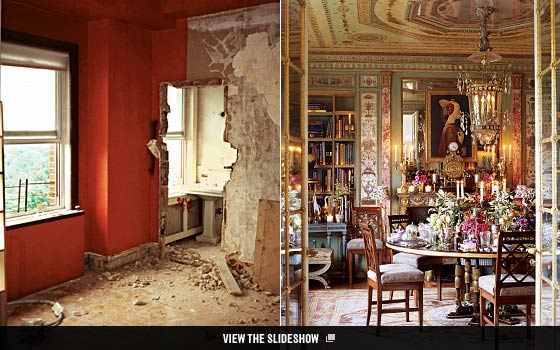
Howard Slatkin, an interior designer with rarefied tastes—every inch of his apartment has been as custom-designed as a couture dress—and rarefied clients (so much so he would rather keep them private), doesn’t seem like the type to head off into the woods in search of creative renewal. No, his “Outward Bound” experience, as he calls it, took place fourteen stories above Central Park. “I was definitely looking for what I think in the real-estate business is called the ‘handyman special,’ ” Slatkin says, describing the 6,000-square-foot residence on Fifth Avenue he created for himself in the mid-nineties by joining two apartments, then demolishing every room so he could start from scratch. The process took three years.
Slatkin had lived in a postwar building on the Upper East Side, in a boxy modern apartment that provided a convenient location for business but scant inspiration. “I wasn’t willing to move and start that odyssey until I could afford to get the apartment of my dreams,” he says. Those dreams included the following nonnegotiable requirements: a Fifth Avenue location, park views, 6,000 square feet, and eleven-foot-high ceilings.
The building is a classic prewar, as were the two apartments he took over, but now, the minute you step off the elevator, you are folded back even further in time, into a world where comfort and elegance reign. The hallway seems lit by the moon, with eighteenth-century sconces throwing off just enough light to vaporize any stress from the city streets below. The boiserie-lined rooms are filled with flowers, an important collection of art, and tablescapes sculpted with porcelain objets and other bibelots. Underlying all this beauty is a strict regime of housekeeping. The table settings for flawless dinner parties are photographed and kept in albums for reference. The guest-room closet comes fully outfitted with clothes and other necessities, just in case the airline temporarily loses your luggage en route to New York.
It’s a rarefied world, all right, but also one that is designed very much to be lived in. “It means nothing if something is beautiful but doesn’t age beautifully and isn’t easy to maintain,” says Slatkin, whose work for clients is seldom in the public eye. “When you look at these buildings, they are all secret societies. You never get a chance to see what the great ones look like. I think it is almost like New York’s great mystery.”

Dining room, before. Photo: Courtesy of Slatkin, Inc.

Library, before. Photo: Courtesy of Slatkin, Inc.

Library
The new floor”“inspired by a basket-weave marquetry pattern I saw on a commode at the Charlottenburg” palace in Berlin”was installed by Russian artisans by hand, inlaying six different types of wood. In all, there are roughly 12,000 pieces.
Photo: Tria Giovan

Kitchen, before. Photo: Courtesy of Slatkin, Inc.

Kitchen
The kitchen and the bathrooms are the only spaces in the apartment that had to adhere to the original floor plan. This room”inspired by the St. Petersburg palace of Alexander Menshikov (who was a favorite of Peter the Great until his embezzling ways got out of hand)”is what Slatkin calls “a wild mix of Delft-style tile walls and ceiling,” with an inlaid wood floor whose geometric pattern he had copied from a seventeenth-century Dutch painting. After it was installed, Slatkin had it “beat up,” because “I wanted the whole apartment to have a patina and “history.’”
Photo: Tria Giovan

Living room, before. Photo: Courtesy of Slatkin, Inc.

Living Room
Slatkin gave the 44-foot-long drawing room an antique-oak parquetry de Versailles floor”“but installed upside down, as I wanted it rough and rustic, with lots of texture.” It was then bleached, limed, and pickled to remove the honey color, and glazed in different shades of gray (about ten coats) to look worn and pale. “I wanted the whole room to be pale and chalky, as if in a cloud, floating above Central Park.” The floor has been finished with four coats of satin polyurethane, so it just needs to be damp-mopped, not waxed.
The porcelain collection on the Regency and Louis XVI wall brackets are Chinese-export birds that belonged to Slatkin’s grandmother. Each bracket has been carved out to accommodate a little lightbulb that illuminates each bird. “At night, the birds appear to be glowing from within, and seem rather happy on their perches,” Slatkin says. “It’s all about lighting”Get the lighting right, and any room is magical.
Photo: Tria Giovan

